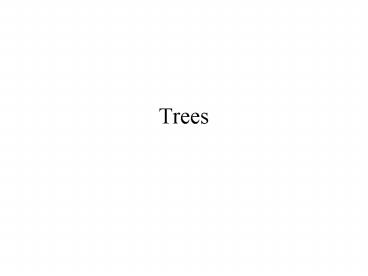Trees PowerPoint PPT Presentation
1 / 17
Title: Trees
1
Trees
2
What is a tree?
- A tree is a set of nodes connected by edges that
indicate the relationships among the nodes. - A tree is a special form of a graph.
- The nodes are arranged in levels that indicate
the nodes hierarchy.
3
The family tree
- At the top level of a tree is a single node
called the root. - The nodes of each successive level are the
children of the nodes at the previous level - A node that has children is the parent of those
children. - Children that have the same parent are called
siblings.
4
Extended Family
- Children are the descendants of all nodes above
them in the hierarchy. - Parents are ancestors of all nodes lower than
them in the hierarchy that have a path from the
parent to the descendant node.
5
Back to Botany
- A node with no children is called a leaf node
- A node with children is an interior, or non-leaf
node.
6
Some final terminology
- The height of a tree is the number of levels in
the tree. - A path is a set of edges that connects two nodes
in the tree in a strictly descending (or
ascending) hierarchical order. - The length of a path is the number of edges that
compose it.
7
ADTs can be recursive too
- The tree ADT is recursive in nature.
- Each node in the tree is itself a tree.
- This includes the empty tree.
8
Some Real WorldTM Examples
- Org Chart
- Playoff Chart
- Table Of Contents
9
Some Computing Examples
- Expression Trees
- Game Trees
- Decision Trees
10
Big Families
- How many children can a node have?
- We are used to dealing with binary trees, but a
general tree can have any number of children. - A tree with no more than n children per node is
called an n-ary tree. Thus, the binary tree has
no more than 2 children per node.
11
Full and Complete
- For a strict n-ary tree, there are two more
conditions of interest to us, which are fullness
and completeness. - To say that a tree is full, is to say that each
non-leaf node in the n-ary tree has exactly n
children. - To say that a tree is complete is to say that it
is full to its next to last level, and that the
last level is filled in from left to right.
12
Guess the number of nodes
- A full or complete tree can calculate the number
of nodes with the formula nh-1, where n is the
number of children per node, and h is the height
of the tree. - This can also be expressed as the sum from i0 to
h-1 of ni - You can reverse the calculation to calculate the
height of a tree with x nodes, which is logn(x1)
13
OK, Now What?
- So, now we know what all the parts of a tree are
called. What use is it? - In order to do anything with the tree, we have to
be able to access the nodes in the tree. - For bags, and stacks, and sets, and lists, this
was a straightforward process, you just move
linearly through the structure. - Our new structure now has an extra dimension.
How do we move through this to visit all the
nodes?
14
Traversals
- A method of walking through the nodes of a tree
is called a traversal. - There are two basic categories of tree traversal,
breadth first, and depth first. - In breadth first, we treat the levels of the tree
like linear structures, and walk through each
level in order. - The primary breadth first search is called a row
order traversal.
15
Traversals
- In depth first, we walk through the tree in
varying order dependent on the subtrees. - There are three main depth first traversals,
preorder, inorder, and postorder. - preorder visits the root, then the left, then the
right. - inorder visits the left, then the root, then the
right. - postorder visits the left, then the right, then
the root. - Note that inorder does not map to a general tree,
but only makes sense for binary trees.
16
Traversals
- The inorder traversal is of course how we
typically write these expressions. - The postorder is how, for example, an HP
calculator expects its input - The preorder is how many functional programming
languages operate (e.g., Lisp, Scheme), and
indeed, how functions are written the function
name comes first, then its arguments.
17
Special Trees
- Binary Search Tree must have comparable items,
and all items in the left subtree are less than
all items in the right subtree. - Heap must have comparable items, and the root
of any tree is the smallest (minheap) or largest
(maxheap) of the tree.

